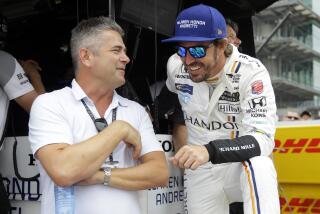Life in Fast Lane Long Before Ferrari Crash
UPPSALA, Sweden — Before he shattered a red Ferrari in Malibu and became grist for Internet legend, Bo Stefan Eriksson ran a criminal gang in Sweden, raced cars in Europe, skippered a yacht called Snow White and helped run a video game company with dreams of taking on Sony and Nintendo, according to police and bankruptcy investigators.
Eriksson had a rap sheet and the fading charisma of an athlete past his prime, but one who was skilled at creating the aura of money and sinister chic. The arc of his triumphs and travails intersected with the ambitions of his partner, Carl Freer, a fellow Swede with a keen mind for technology and a confidence that captivated investors.
The two men were executives in Gizmondo Europe Ltd., a London-based company that developed a hand-held computer game that one industry writer described as having more gadgets than a Swiss Army knife. Gizmondo was abuzz with hype and promise. In March 2005, the launch party for the new game at the Park Lane Hotel was stocked with champagne, rhinestones, pearls, paparazzi and celebrities such as Busta Rhymes, Danni Minogue and Sting.
But beneath Gizmondo’s flash ran the darker threads of corporate gambles, of technological innovation and ingenious ideas unhinged by mismanagement and greed, according to investigators and people affiliated with the company. Gizmondo went bankrupt in January, amassing more than $300 million in debt in its three years of existence, according to corporate records.
As the company spiraled and unpaid bills lined up, Freer and Eriksson headed from Britain to Los Angeles, leaving a trail of private detectives, bodyguards, $1,500-a-day lap dancers and millions of dollars worth of homes, cars, diamond watches and other accouterments of those who get rich quick. The tempest around Gizmondo’s slide intensified in February with Eriksson’s spectacular 162-mph crash of a rare Enzo Ferrari on Pacific Coast Highway.
Court-appointed liquidators are combing through thousands of pages of Gizmondo documents, but no one knows where all the money went, or how Eriksson and Freer transplanted their personal wealth and reinvented themselves in California. Financial investigators are also examining why investors and Gizmondo’s parent company, the Florida-based Tiger Telematics Inc., were not aware that Eriksson was a felon, as were at least two other people connected with the company.
A Securities and Exchange Commission filing reveals that in 2004, Eriksson was paid a salary of $867,465 as a senior executive and $2.3 million in bonuses, stock awards and other compensation. Freer, Gizmondo’s managing director, earned more than $1 million and received $2.4 million in stocks, bonuses and perks.
The company also took care of people close to its management: Freer’s wife was a high-paid consultant for marketing and public relations. Another senior executive’s girlfriend worked as a corporate secretary at Gizmondo and was paid more than $232,798 in salary and bonuses, given a luxury car and company stock then valued at $467,213, according to the SEC report.
“They’ve lost a hell of a lot of money, more money than most people see in a lifetime,” said Paul Davis, a British liquidator investigating company records. He said between January and September 2005, Gizmondo took in about $2.6 million but lost more than $263 million. “They are staggering numbers by anybody’s standards. It’s clear the directors lived lavish lifestyles with fast cars, planes, boats and travel. But certainly that wouldn’t account for all of it.”
*
Charges Pile Up
The fates of Eriksson and Freer are also in question. Eriksson, 44, is in jail in Los Angeles awaiting trial on charges that include embezzlement, grand theft auto, illegally possessing a Smith & Wesson .357 magnum and driving while intoxicated. The counts arose from the Feb. 21 car accident and have become part a widening investigation into his activities after he entered the U.S. in August with two Ferrari Enzos and a Mercedes-Benz SLR McLaren, valued at $3.8 million and owned by British financial institutions. He had a lease contract on the vehicles, authorities said, prohibiting him from taking them out of the country.Eriksson has pleaded not guilty. His lawyer, David Elden, said that Eriksson put down about $1 million for the three cars and was in negotiations to sell his British mansion to pay off the balance on the vehicles before he was arrested. Elden described Eriksson’s case as a “non-injury accident being blown out of proportion because it involved a Ferrari.”
Real estate records show that Freer, 35, moved to the U.S. about the same time as Eriksson. He was arrested April 26 by Los Angeles County sheriff’s detectives on charges of impersonating a police officer to buy at least one gun. Police said they confiscated 12 rifles and four handguns from Freer’s Bel-Air home and his 100-foot yacht docked at Marina del Rey.
The incident was not Freer’s first criminal case.
In October, a court in Stuttgart, Germany, sentenced Freer to 18 months probation and fined him 200,000 euros for buying four luxury cars with bad checks and having them delivered to a dealership in France. The cars were ordered between 1999 and early 2000, and German authorities issued an international warrant against him. Freer contended that he had canceled a check after believing he was being sold stolen cars.
Los Angeles County sheriff’s detectives are also investigating Freer’s and Eriksson’s membership in an “anti-terrorism unit” of the San Gabriel Valley Transit Authority, a small private company that provides rides for the disabled and elderly in Monrovia and Sierra Madre. Sheriff’s deputies on Tuesday arrested the transit agency’s founder and seized guns, badges and police cars from offices and homes connected with the company.
Freer declined an interview request from The Times. Instead, his public relations firm, Sitrick & Co., responded to written questions. It said Freer was interested in the transit operation in order to test facial-recognition technology in the agency’s vehicles. Elden said Eriksson also wanted to use the authority’s buses to demonstrate a video system he had hoped to market as an anti-terrorism tool.
Eriksson’s alleged affiliation with the transit authority is a contrast to the glamour, chauffeurs and musky woods of his old neighborhood in St. George’s Hill, one of London’s most exclusive suburbs. Along the community’s winding roads, Eriksson was known for his sleek cars and long parties.
“A lot of very wealthy people lived up there,” said Alan Koombs, a security guard for the gated community. “People like [pop singer] Cliff Richard and football stars and an influx of Russians with backgrounds you can’t trace and very big minders [bodyguards]. Stefan lived at a house called the Washington. He projected himself as a Russian or Romanian, certainly not as a Swede. The residents association up there certainly didn’t like” his lifestyle.
*
Building a Reputation
Peel back the years to the late 1970s, when Eriksson was a beefy kid moving through the streets of Uppsala, a college town northwest of Stockholm. They called him Fat Stefan. The nickname stuck, even though Eriksson later joined a gym, pumped weights and began moving more like a linebacker than a bullied boy on the playground. In a nation not accustomed to violence or interconnected networks of criminal gangs, Eriksson both fascinated and frustrated the local police.“We first got our eyes on him in 1980,” said Kjell Soderberg, chief detective inspector for the Uppsala Police Department. “He was suspected of some thefts. They weren’t ordinary. They were special. He’d drill holes through store walls to steal car parts. He was more imaginative than other thieves.”
Eriksson began constructing his own underworld. Police say he pulled in friends like Johan Enander, a muscular man trained in martial arts and known as the “torpedo,” or debt collector, and Peter Uf, described by police as a shrewd operator. After serving prison terms for violent and financial crimes, both men would join Eriksson in Gizmondo-related business. But their attention was first focused on Sweden.
In 1988, Eriksson was convicted of possessing a shotgun and selling 10 small bags of cocaine. He spent about two years in prison.
Shortly after his release, authorities say, Eriksson orchestrated plots with more nuance and complexity. Local police joined federal detectives in investigating what became known as the Uppsala gang. Swedish police sketched a flow chart of Eriksson’s network that included investigations into drugs, robbery, extortion, counterfeiting, bank fraud, arms trading and contacts in Eastern and Western European criminal syndicates.
In the early 1990s, Eriksson was a familiar face in cafes and bars from Uppsala to Stockholm. Police and those who would later know him at Gizmondo said he was a master of mystique, projecting himself as a wealthy, dangerous and clever playboy who was as comfortable dealing with financiers in Brooks Brothers suits as he was men with guns hidden in black leather coats. He attended, along with members of the Hells Angels, the wedding of Serb Milan Sevo, a leading figure in Swedish organized crime.
His love of fast cars was well known, but investigators were startled when in 1992 a tanned and confident Eriksson motored up the Fyrisan River here on a yacht named Snow White. “That was a very big boat in a little river,” said Soderberg, the Uppsala chief detective inspector. “They were calling attention to themselves. How were they paying for cars and a boat like that? It wasn’t really clever, when you think about it.”
In 1993, Eriksson was convicted and imprisoned on charges of assault, making threats and attempting to inject as much as 20 million counterfeit Swedish kronor, about $2.6 million at the time, into the country’s money supply. While in prison on those counts, he was convicted in a separate case for enlisting at least one bank employee to falsify deposit and checking slips to divert money to Eriksson’s connections in Sweden and to secret accounts in Spain. Police estimate that more than $7 million was stolen.
*
The Freer Connection
Eriksson was released from prison in 2000, needed a job and got one through Carl Freer. Investigators believe the two first met years earlier. Freer’s public relations firm described Eriksson as a “very old friend” who possessed “great talent” as a salesman. Eriksson went to work in Stockholm for a Freer venture known as Eagle Eye Scandinavian Ltd., which specialized in telecommunications and global positioning systems. Freer also had managed a media firm, a film production company based in Spain and an auto dealership in Cannes, France.Swedish police say they suspected Freer of fraud several times over the last decade, but he was never charged. Through a spokesman, Freer said he was not made aware of such investigations. A Swedish newspaper reported last week that authorities first became aware of Freer when he was 18 and forged his parents’ signature on a loan. A Swedish detective confirmed the incident. Freer contends that he had his parents’ permission to sign on behalf of them for a student loan.
“He carefully plans,” Soderberg said. “He has a tremendous verbal capacity. He could sell sand in the Sahara and refrigerators to Eskimos.”
Freer moved to London around 2002 to head the European division of Tiger Telematics, a former flooring company with offices in Jacksonville, Fla. Freer and others moved the corporation into developing child-tracking computer devices and other wireless technology that could locate “people down to the street level in countries throughout the world.”
*
The Gizmondo Venture
But Freer’s attention shifted to video toys and an invention called Gizmondo. Several people who know Freer, whose father was a nuclear engineer and an IBM programmer, called him a technological visionary with extraordinary business and verbal gifts. A heavyset man with a boyish face who enjoyed being driven around in a Rolls-Royce, Freer had little inhibition and an infectious charm that impressed financial backers.“I’ve heard Carl say the most unbelievable things and people listen,” a former Gizmondo employee said.
Freer and Steve Carroll, an engineer credited with creating the game, were determined to shake up the industry with a console that would also play music, movies, contain a digital camera and send and receive e-mail messages. Gizmondo Europe moved into a store on stylish Regent Street in central London. And Eriksson, who drove a Ferrari plastered with Gizmondo signs at the race in Le Mans, France, was named company director.
“We spent three years of our lives totally dedicated to this from conception to launch,” said Carroll, whose girlfriend, Tamela Sainsbury, was a company secretary with a salary and bonuses of more than $700,000. Carroll spoke briefly to a reporter over the phone recently. He asked the reporter to call back at a specific time, but he didn’t answer after hours of repeated calls.
Freer believed the game would rival the hallmark names of Sony and Nintendo, said the former Gizmondo employee, who asked not to be named for fear of retaliation by Eriksson. “There was massive excitement in the house about this. Carl was passionate about it. He thought it would be triumphant. They believed it would make them terribly rich. But greed and egos led to the downfall [and] Stefan’s cocaine problem was out of control” in 2005, the ex-employee said.
Eriksson twice faced cocaine-related charges in Sweden — in 1988 when he was convicted of selling the drug, and in 2002 when he was fined 4,000 kronor, or about $550, for using cocaine and amphetamines.
Noel Hogan, a private investigator tracking the luxury cars Gizmondo had leased from British banks, said personal enrichment drove company executives: “All of Gizmondo was to fund a lavish lifestyle. When you invest in a company, you don’t want the directors having 12 cars and having their girlfriends on the payroll . But then the water went out of the bath and the tap wasn’t on anymore.”
A financial consultant hired by Gizmondo said the company was poorly managed and had little understanding of marketing. “They grew at an astronomical rate. I call it over-trading,” said the consultant, who like many affiliated with the company asked to remain anonymous for fear of retaliation. “I think the product itself was terrific, but it had some slight hitches that needed to be worked out. Maybe it was all too overly ambitious.”
*
Road to Bankruptcy
The company’s financial problems didn’t stop its executives’ buying sprees. A former employee said Freer bought three homes for a total of nearly $15 million and owned a yacht valued at more than $10 million. Eriksson bought cars, watches, cocaine and often hired lap dancers from the Spearmint Rhino club in London, the former employee said.Michael Carrender, chief executive of Tiger Telematics, said the company and a board of independent directors grew agitated in 2004 and 2005 over Gizmondo Europe’s financial practices, especially after millions of dollars were spent on advertising and the game failed to make it to market by the date promised. The games were eventually manufactured and sold, but the company continued to lose money.
“In hindsight, it looks as if there was clearly self-dealing and perhaps a violation of fiduciary duties,” Carrender said of Freer’s and Eriksson’s management styles in telephone interview this month. “It wasn’t attractive.”
When asked why Eriksson, a felon with little experience in technology, was made a senior executive, Carrender said, “That’s an interesting question.” He added that background checks run on Eriksson detected no criminal charges.
“We literally could find nothing,” Carrender said. “We couldn’t find it. He didn’t tell us.” He added that Eriksson, who spoke poor English and was often not understood at board meetings, was brought to the company by Freer to offer “strategic introductions” to high-profile car racing personalities who might promote Gizmondo.
Freer’s public relations firm, however, said, “The people at Tiger Telematics were well aware of Stefan Eriksson’s background.” The firm also said that Freer invested much of his own money in Gizmondo and that the company “came within a hairsbreadth” of success.
As Gizmondo tumbled further into debt in 2005, the former employee said, “Stefan was rarely there. He’d come to business meetings, put his feet on the table and read glossy car magazines . They collected watches. Last September, Stefan had 685,000 British pounds sterling [$1.3 million] worth of watches. Rolex. Cartiers. Mostly diamond-encrusted.”
Some who did business with Eriksson and Freer had a foreshadowing of Gizmondo’s crash. “They’d come in on a regular basis,” said a London jeweler who knew the men for two years.
“At the beginning, they were as good as gold. Carl was more of a businessman, Stefan more of the playboy . But nine to 10 months ago, the payments to us were slower coming in.” The jeweler said he complained. “If I hadn’t put my foot down, I’d be holding the baby like everybody else. Two of my friends lost 2 million British pounds sterling [$3.78 million] each. One was in the car business, the other in the jewelry trade. They played the part of millionaires, and that’s why everyone got dragged along.”
At the end of the business day Jan. 20, 2006, Gizmondo Europe filed for bankruptcy. The stock of Tiger Telematics has plummeted to 7 cents from $32 a share in January 2005. Eriksson and Freer quit the company Oct. 18, 2005, after a story appeared in a Swedish newspaper about Eriksson’s criminal past. Their resignations scared off investors.
“Our fundraising just dried up,” Carrender said. “We simply ran out of cash.”
But by then, Eriksson and Freer had already moved to the U.S. Freer docked his yacht in Marina del Rey and invested in a firm called Xero Mobile, a company planning to offer free phone service to college students if they viewed at least 20 minutes of advertisements scrolling on their cellphones each day. He has since severed his business relationship with Eriksson.
Eriksson, who authorities say misled U.S. immigration by not declaring that he was a felon, settled into a $3.6-million Bel-Air mansion.
About 6 a.m. on Feb. 21, according to police, he and another man, Trevor Karney, were speeding in a red Ferrari west of Decker Canyon Road when they hit a power pole, shearing the car in half. Both men walked away, Eriksson with only a bloody nose. After his arrest April 7, police raided Eriksson’s home and found two expensive watches, brass knuckles and a poster of the movie “Scarface” above his bed.
*
Fleishman reported from Uppsala and London and Winton from Los Angeles.
More to Read
Start your day right
Sign up for Essential California for news, features and recommendations from the L.A. Times and beyond in your inbox six days a week.
You may occasionally receive promotional content from the Los Angeles Times.








